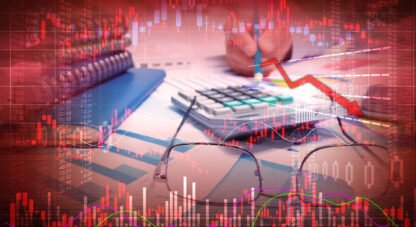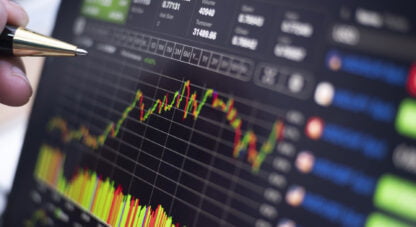Podcast: Play in new window
- Rates on 30 year mortgages rising at fastest pace since 2003
- Gold up 13% over 12 months
- Ex-FED President Dudley “The Fed will have to shock the markets”
The McAlvany Weekly Commentary
with David McAlvany and Kevin Orrick
Inflation Makes You The Designated Loser
April 11, 2022
“Eight-point-five is not comparable to what we had under Volcker. In fact, if you’re talking about the Volcker era measures, you’d be closer to 13. So I go back to gold. Gold’s up 13% over the last 12 months. Basically, it’s got you at break even. It’s interesting because your alternative stinks. Your alternative is a guaranteed loser. Again, you have been— in the policy suite being chosen and implemented in the economy, you have been designated the loser.” — David McAlvany
Kevin: Welcome to the McAlvany Weekly Commentary. I’m Kevin Orrick along with David McAlvany.
Now, Carmen Reinhart a few years ago was a co-author of a book called This Time Is Different. And I think a lot of times, Dave, when we look back at history, we go, okay, well, the only way we can predict the future is based on something that we’ve seen in the past. What we would change from the past or what we would do the same. But what we’ve had recently, Dave, this inflation, along with the overvalued markets, along with the potential for recession, it may be different this time. And the Bank of International Settlements is saying we cannot sustain this.
David: Those are famous last words, and of course, Reinhart and Rogoff were using that as sort of a play on words that no, maybe it’s not different. It’s only different in the sense, Kevin, that there’s a lot of people who don’t know what we’re talking about when you talk about inflation, because it’s been an entire era. It’s been a gen— more than a generation.
Kevin: I was a teenager.
David: Ninety-five percent of asset managers today have never managed money in the context of inflation. They don’t know what changes. Frankly, corporate executives don’t know what changes and what’s the different approach that needs to be taken in light of balance sheet management with inflation in the mix. You like the idea of being able to raise prices, and sometimes you can, but there are also thresholds to that as well.
The Bank of International Settlements is the central bank to central bankers. And they said this week, “We may be on the cusp of a new inflationary era. The forces behind high inflation could persist for some time, and the structural factors that have kept inflation low in recent decades may wane as globalization retreats. That change requires a broader recognition in policymaking that boosting resilient long-term growth cannot rely on repeated macroeconomic stimulus, be it monetary or fiscal. It can only be achieved through structural policies that strengthen the productive capacity of the economy.”
Kevin: So it’s what you’ve said over and over. You cannot run an economy just with quantitative easing. And the transitory episode, which is what we’ve been sold, is actually a long-term era, is what BIS is saying right now.
David: Yeah. So it’s noteworthy because it is the bank to the central bankers, and they’re considering an inflationary era, not just a short inflationary episode. And I think one of the things that is getting baked into the larger conversation today is the impact of inflation on lower income economic strata.
Kevin: Well, look at inflation now. I mean, what is it? It’s over eight.
David: Yeah, fresh CPI print this week at 8½%, that’s up from 7.9%. Core was not quite as bad as expected, but the headline was supposed to be eight-four, and it came out at eight-five. That places the 10-year Treasury at the most negative, real yield in US financial market history.
Kevin: Wow.
David: So the PPI, producer price index, is going to come out later this week and we’ll also have the University of Michigan sentiment statistics. Both are likely to be ugly. PPI is already at 10. With the month of March and the increase in fuel and the cost pass-throughs that we see in the wholesale market, 10% is just the beginning. Where do we go from here?
Kevin: What a difference a year makes. I mean, when we were sitting here last year, the Fed’s like, gosh, do you think we can get inflation up to 2%? We’re at 8%, 8½% at this point.
David: Yeah. Inflation management is what the Fed has determined to be a key element of economic stimulus. They basically said, look, we’re going to target 2%, and that is what we consider to be a healthy rate of inflation. Because on the basis of a 2% inflation rate, we’re going to have “healthy economic growth.” And of course that’s debatable. As it turns out, inflation is now a little too hot to handle, and—
Kevin: Well, and I wonder, are they going to panic? I mean, they’ve acted as if it’s not even here. Now, that it’s 8½%, what is the reaction that we should expect?
David: Yeah. I loved Mohamed El-Erian’s comments in the Financial Times this week. He says, “This situation is particularly acute for the Fed, given its gross mischaracterization of inflation for most of last year, together with its failure to act decisively when it belatedly recognized the price instability had taken root under its watch.” So he says basically there’s two questions. “Is the world’s most powerful central bank finally committed to return monetary policy to serving the real economy rather than financial markets, and can it do so in an orderly fashion?”
Kevin: You know what this reminds me of? Speaking of panic, a couple years ago, my son and I were grilling bratwursts out on the patio. It was sort of a one of those days where it just felt completely calm. So we moved the grill underneath— There’s a covered patio. We were fine. We were grilling those bratwursts. But the temperature got up higher than we thought because of the fat. You know how that works?
David: Yeah.
Kevin: That fat drips off. And all of a sudden, the propane grill burst into flame. And we had about a three and a half, four foot flame coming off of there. Now, the difference between sitting and relaxing and smelling the brats and all of a sudden having a four foot flame, you can imagine, at that point, we were doing things that we weren’t doing seconds before out of panic. Now is the Fed going to realize that they’ve been cooking bratwursts and the fat is now finally catching on fire?
David: You never really appreciate the impact of nature and of nature’s many elements until you’re in the middle of something. And I remember my first job at a college was at a study center in the middle of nowhere in Texas. And we did various cultural explorations, the arts, that’s actually where I met my wife. She was giving a speech on postmodern philosophy and its influence on contemporary dance. And so the arts was a part of the thing. Anyways, while I lived there, I joined the volunteer fire department.
Kevin: I didn’t know that.
David: Yeah. And so there’s a fire just down the road. And I get there along with everybody else, and somebody’s left a lamp on in an upstairs closet, and the whole house is in flames.
Kevin: Oh wow.
David: And you would not believe the heat that that throws off. But then there’s this— I mean, we’re moving inside, we’re making sure that people are out. And you would not believe the amount of destruction brought by the water that’s used to put out the fire. So, I mean, you’ve got Fed policy reactionism, and inflation suppression that I think is going to look like a fire brigade, hitting a flaming house. Everything gets wet from here. And what the fire has not burned is going to be damaged by the smoke or further destroyed by the water.
So inflationism was all along something to avoid playing around with. But the temptation by the PhDs, with a little bit of hubris thrown in, controlling growth, being in charge of the economic levers, that temptation proved too great. Inflationism has been what we’ve had for decades. Play with fire, you’re going to get burned. We know the consumer is feeling the heat. We know that the bond-holder in the first quarter has really felt the heat. And now the question, and it’s a good question that El-Erian asks in the Financial Times, will the Fed’s reputation merely be singed or will it be incinerated? Because that’s what’s at stake, is the Fed’s reputation.
Kevin: Yeah. And the Fed, they have increased their balance sheet month by month by month. And now they’re talking about decreasing the balance sheet. So no longer QE, but we’re talking QT at this point, aren’t we?
David: That’s right. And El-Erian hits the nail on the head. He’s like, don’t look at this flip flop of on and off and on and off as some version of nimbleness, it’s going to have a lot to do with the pain thresholds that they’re willing to tolerate in terms of the market volatility that they create. So the goal at the Fed, as stated in recent days, is to reduce the size of the balance sheet. The estimate is $95 billion a month. They also want to deliberately raise rates to the neutral level—neutral kind of a vague connotation, but neither too hot nor too cold. Of course, the a hundred trillion dollar question—probably more than that at stake here between stocks and bonds—is whether they tame inflation without A, triggering a recession, or B, imploding asset prices, specifically stocks and bonds.
Kevin: So are they going to react in a way that will actually shock the system? Dudley this last week said that’s what’s going to have to happen.
David: I like some of these ex-Fed presidents when they’re no longer in the seat and can speak their minds. He was quoted as saying, “The Fed will have to shock markets to achieve the desired response. This will mean hiking the federal funds rate considerably higher than currently anticipated. One way or another, to get inflation under control, the Fed will need to push bond yields higher and stock prices lower.”
I did a news interview this morning and I was asked the question about recession, the dreaded R word. And I merely quoted Clinton’s Treasury Secretary Larry Summers, who later became Obama’s director of the National Economic Council. There’s a 50% odds of a recession in one year. There’s a hundred percent odds, probability, in two years, based on the unemployment rate and the inflation rate, the math is the math. And while you can argue, nothing is inevitable, you have to consider the state of the consumer and what they face on a daily basis, which is another version of the math. This is Joe and Susie lunchbox, what they face every day at the store, at the gas pump. It’s like Conagra, they’re bumping their prices of Slim Jim meat snacks, 26% over the next two years. So fat pricing on Slim Jim, right? This is what Joe and Susie lunchbox face every day. Summers was quoted in the Washington Post saying, “The optimists have their macroeconomics wrong. True, more job seekers might restrain wages, but more workers earning and spending raise demand and prices. There is a first time for everything, but over the past 75 years, every time inflation has exceeded 4% and unemployment has been below 5%. The US economy has gone into a recession within two years. Today, inflation is north of 6%. Unemployment is south of 4%.” R is for recession.
Kevin: Yes. But what about Build Back Better? Build Back Better. Isn’t that supposed to get rid of inflation for us? Just spend a couple of trillion and you get rid of inflation.
David: Well, not all economists are created equal, although most of them look and sound a lot alike at certain points. So you contrast Summers’ opinions, with inflation, its consequences, and recession coming, with Joseph Stiglitz’s. I’ll be honest, I’m not a fan. Sixteen other Nobel prize winning economists he wrangled together to write an open letter defending the Build Back Better legislation, basically saying, look, we can put in a couple trillion dollars and you’re going to push prices up a little bit, but that extra fiscal stimulus, it is not going to add to the threat of inflation.
Now I think to myself, these are smart people. I mean, it’s no small task to finish a PhD, to do fellowship X, Y, and Z, to teach for years and years, and your whole life to be about reading books and learning. The 16 PhDs—and we’re talking about 16, actually—Nobel Prize-winning economists who look and say, you can put the better part of two and a half trillion dollars in fiscal spending into the economy and you’re not going to exaggerate or add to the threat of inflation?
Smart people are not always rooted on terra firma, which really makes me appreciate Summers even more. And I’ll be honest. I mean, we may not see eye to eye in politics, but from the Summers-Barsky thesis in the 1980s till now, and his comments on inflation, he was way ahead of the curve on the fact that it was not going to be transitory. And I think he’s way ahead of the curve in terms of saying yes, recession is, at this point, built in. It’s inevitable. We are moving there.
Kevin: Well, and Summers-Barsky just basically says that gold’s going to go up until interest rates exceed inflation enough, right? I mean, gold rises, that’s one of the only go-tos until you can keep up. Wages aren’t keeping up either.
David: No, and that’s one of the things we got the eight and a half percent number on the CPI, but real average hourly earnings fell for the 12th straight month. So when you think about consumer sentiment statistics, and we’ll get the most recent ones later this week, but they’re falling. Yeah, and this is the centerpiece. Economic activity has picked up, post-pandemic, and many of your indicators point to economic vitality. But the consumer is really the crux here—68 to 70% of GDP. These folks are feeling the inflation pinch, and they’re being forced to reorganize spending away from discretionary items towards only the essentials. And this is, I think, one of your things to watch. Consumer discretionary stocks have remained weaker than either tech—which frankly was worse even than the S&P and the Dow— Yeah, so your general indices, they’re still off 15%. Okay. And that’s recovering off of a 24% decline from the 2021 peaks. So, that’s an area to watch, consumer discretionary stocks. It tells you one more thing about a coming recession. The fact that the vast majority of people are under pressure.
Kevin: It wasn’t just a year ago that you couldn’t find a boat. You couldn’t find one of those teardrop trailers, all these discretionary types of things. Money was just flowing. So people were buying discretionary things. You look now, and you see for sale signs on boats, teardrop trailers, people are starting to feel the pinch at this point. They may be getting rid of luxury items at this point, but the truth is, the recession comes right after that.
David: Yeah. And this is where I think looking at all of the signals and trying to figure out what is happening, there’s a lot. And lot of it is confusing when you mix it all together. Five percent of GDP is attributable to an inventory build. We covered that in a meeting this morning. And if GDP is being propped up by inventories, and those inventories are not flying off the shelves, then we’ve got a digestion problem here in 2022. And in support of this big, significant issue with inventories and their contribution to GDP is the fact that we’ve got a significant decline.
If you’re looking for supporting evidence, a decline in shipping rates, whether it’s your bulk shippers or the boats that are contracted to bring those 40-foot containers from Asia over here, 40 to 50% decline in shipping rates over the last couple of months. And so it’s telling you about the demand side, both in terms of finished goods. I think it also has something to do with the closure of Shenzhen and a number of Chinese ports where they don’t have truckers to move product.
And so you’re having to slow down the process, which, again, what are we seeing? Is it a slowing in the global economy or is it round two? Is it round two of supply chain disruptions? Which leads to another round two of pent up demand, excess demand again in 2022, and a lull in the inflation statistics as we come into the next few months, April, May, June. But maybe even bounce back with those inflation statistics, if in fact it has to do with COVID more than it does end demand here in the United States.
Kevin: Okay, a lot remains to be seen, but for now, you have to beat inflation somehow. I mean the real inflation or real income or real interest is very different than nominal.
David: Right. And I think, again, if you’re talking about the consumer being the centerpiece and consumer sentiment being under pressure as inflation comes up, you’re talking about a real problem. Building on the real, or inflation, side of the equation, we had JP Morgan in the last week put together a guide to the markets—this was actually at the end of March—with some very revelatory charts. And one chart showed the amount of income needed to beat inflation in a savings account. And it looked over the last 30 years or so. We think about the last few years being rough because inflation’s picked up, but compliments of the Federal Reserve’s policy choice, again, 2% targeted inflation rate, 18 out of the last 21 years, the income generated in a savings account has been far less than the inflation rate.
Kevin: Well, and that’s no surprise. That is no surprise. We’ve had to learn over the last couple of decades that you’re not going to keep up if you just put it in a bank.
David: But I think what we don’t realize, Kevin, is that we’ve had some version of negative rates for a long time. We thought, how weird is it that this— We’re talking about negative nominal yields in Europe and how bizarre. Who would put money into a negative yielding bond?
Kevin: Yet we do, month by month, year by year.
David: Eighteen in the last 21 years, income generated in a savings account has been a losing equation. When you factor in inflation, in real terms, you are losing money. Eighteen out of the last 21 years.
Kevin: Habits are hard to break Dave. When I get money, I put it into the bank. Why? It’s habitual.
David: This is not a new problem. It’s just a problem that’s getting bigger. For the sake of economic growth, so the argument goes, savers and households have been the designated losers. They pay the price for the inflation target, they’re the suckers that are to believe that inflation targeting is consistent with the principles and mandate of maintaining price stability. That is maddening in and of itself.
Kevin: I’ve been asking clients to just look at their bank account. Look how much is in there. Let’s say per $10,000 or per $100,000.
David: Per 100K. Per 100K, you’re talking today, per 100,000, you need to generate $8,500 in income to break even in that relationship. Your sacred relationship with your bank costs you 8,500 bucks to break even. How are you doing?
Kevin: Bad habits are hard to break.
David: Well, for 2022, again, you need roughly 8,000, $8,500 on a $100,000 deposit. And as I look at the gold market, I say, okay, gold’s up 13% over the last 12 months. Inflation’s been percolating between 5 and now over 8%. Think about the cost of sitting in a local bank. Rates don’t compensate for the risk of lending and interest rates don’t compensate you for the present tax inflation is putting on those deposits.
Kevin: Well, and I can just tell you, after looking at my bank account, and talking about this all day long with clients, a lot of times you forget to look at your own stuff. And looking at it, I shifted a fair amount of money over to Vaulted last week because it’s like gold’s keeping up, gold is actually beating inflation right now, over the last year. I certainly didn’t keep up with the interest rate.
David: One of the things we engineered into the Vaulted program was something we called the VaultPlan, where you can automatically save a couple hundred bucks out of every paycheck and it automatically gets invested in gold. And again, I look at that $8,500. When I went through the J.P. Morgan charts, I mean, when you— Sometimes a picture is worth a thousand words. You can talk about inflation, you can read the numbers, but the chart shows this gap. And it’s like, okay, it’s a small gap in most years over the last 21, but 18 you’ve been underwater, 18 of the last 21. And now the gap is huge.
Kevin: Well, and you’re still using CPI. CPI has been changed how many times over the last few decades?
David: Fair enough. It’s a defunct measure of inflation if you care about the real number because if you are looking at the real number, you are talking about double digits. And I say that because you’ve had political prerogatives and favors which have driven the BLS to shift the weightings of component parts and alter the methodologies nearly two dozen times—
Kevin: Two dozen times.
David: —since the Volcker era. So when you think about the double-digit rates of inflation we had under Volcker, and we’re at 8.5 today, you may feel some comfort—except that you’re being lied to. Eight-point-five is not comparable to what we had under Volcker.
Kevin: So it’s, if you use it and it’s rising in price, they’re going to take it out of the index.
David: Right. And in fact, if you’re talking about the Volcker-era measures, you’d be closer to 13. So I go back to gold. Gold’s up 13% over the last 12 months. Basically, it’s got you at breakeven. And you say, well, that’s not interesting. No, it is. It’s interesting because your alternative stinks. Your alternative is a guaranteed loser. Again, you have been— in the policy suite being chosen and implemented in the economy, you have been designated the loser.
Kevin: Yes. I am a designated loser. I use food. I use energy. Those are things that they— Do they even exist in CPI or PPI anymore?
David: They do, and of course they get to pare that back when they look at core versus the headline, right? So less to worry about there. But if you draw on the preferred Fed measure of inflation, the PCE—that’s their preferred metric. And this is what they use when they’re putting their policies together. Food and energy once had a 27% share of PCE. They said this is what represents consumer spending. It should have a 27% share in the number. Today, it’s been reduced to 12%.
Kevin: Food and energy has been reduced from 27% of the index down to 12.
David: Now consumption patterns have not shifted that much, but again, this is a preference in terms of how you construct the measure. And PCE, again, food and energy had a 27% share in the number. Now it’s 12%.
Kevin: Yeah, food and energy, that’s a little higher for me than 12%.
David: Yeah. And so if it rings the alarm bell, and again, inflationism is the standard operating procedure amongst central— the central bank community. So if it rings the alarm bell, just mute it, make it go away. Tracking the impact of that inflationism in essence has been obscured, has been obfuscated by methodological shifts and weighting preferences amongst the component parts. So even though, coming back to CPI, even though the current CPI is eight and a half percent, and it seems high, the actual number’s easily five points higher than that. Easily.
Kevin: Dave, I started here in 1987 and started talking about gold in 1987 with my clients. Gold has just kept up with real world inflation. I mean, wouldn’t you agree? I mean, if you take actual inflation, gold still buys about the same amount of bread that it did when I started—and a hundred years ago. It still buys about the same amount of bread.
David: Yeah. I think it’s a very unreliable inflation tracker on a day-to-day basis. It’s not like, okay, inflation’s up one 10th of a percent and gold is matching that.
Kevin: But put it away and forget it.
David: It moves on a very episodic basis. It moves on a very— It’ll do nothing, nothing, nothing. And then investors wake up and they’re like, I think we’ve got inflation. And all of a sudden you see the price adjustment and you’re at a new plateau for the metal. And so it does move very quickly.
Frankly, the inflation-adjusted price for gold, it’s still under its inflation-adjusted price, roughly 27, $2800 an ounce. So I think we have another uptick in the price of gold just to get us to the inflation-adjusted values. And wouldn’t surprise me to see the same thing happen with silver.
So I think gold’s tracking real world inflation. And frankly, that entire move from $300 to $2,000 an ounce over a two decade period, that’s really a consumer salvation story. To the degree you want to sidestep the designated loser category, policymakers are targeting you. They’re targeting your savings as the means by which the great economic hoax continues. How do you [sidestep] that? You move to gold. The economic growth fraud will end, and the job of asset preservation will be complete, but that day is still far into the future.
Kevin: Oh gosh. If we could just go back to the Volcker days, where Volcker could actually raise rates dramatically. You were talking about a Fed shock. He did shock. And because of the debt and because the asset prices were not so overvalued, he was actually able to pull it off without ruining the economy. What do you think now? I mean, they can’t shock the system without literally destroying the system, I don’t think.
David: Well, but think about the system we’re talking about. This is a system that’s built on credit growth. It didn’t used to be, but today credit growth and inflationism are two sides of the same coin. When I talk about the economic growth fraud—
Kevin: Great hoax.
David: —the economic hoax. The great economic hoax. That’s exactly what I’m talking about, is this notion that we will grow infinitely if we just add a little bit more inflation. Okay. Well consider one trader’s perspective on the ability of the Fed to deliver results and not shock the system. In fairness, the backdrop today is more challenging than the Volcker era. Things have changed as a result of this inflationism. But I appreciate a tweet that I read this last week. Volcker couldn’t achieve a soft landing when he raised aggressively during high inflation with markets valued at 40% versus GDP and US debt at 30% versus GDP. But we’re confident we can achieve a soft landing raising rates aggressively with markets valued at 190% versus GDP and debt at 124% of GDP.
Kevin: Do you think the markets really appreciate what you’re saying right there, do you think that they’re concerned?
David: No. There’s not enough concern in the market at this point, not enough concern amongst investors. Here’s the math. Again, numbers, compliments of that JP Morgan asset management piece. If you assume a parallel shift in the yield curve, each 1% move in interest rates creates a loss of 8% for investment grade corporate bonds—
Kevin: Okay. So a 1% move in interest rates up creates an 8% loss in corporate bonds.
David: Investment grade corporate bonds. —a 5% loss in mortgage-backed securities, an 8% loss in the 10-year Treasury, and an 18% loss in the 30-year US Treasury market.
Kevin: So let’s repeat this, because this is where the “safe” money is. Okay? If you’re not wanting to invest in the market, the safe money is 10-year and 30-year Treasurys.
David: There’s not a lot of concern. There is a lot of obliviousness to the nature of how these relationships work. An increase in interest rates, which has to happen if you’re going to extinguish the flames of inflation, has a real cost in asset prices.
Kevin: So a 1% move up is an 8% loss for corporate bonds, an 8% loss in 10-year Treasurys, but an 18 per— 1% up is an 18% loss in 30-year Treasurys.
David: Right. So, when Bullard says that the neutral rate is close to three and a half percent, currently less than a half a percent, but he says the neutral rate is three and a half. Other Fed presidents would say, ah, two and a half. All right. So somewhere, let’s just two a half to three and a half, whatever. Rates getting to those levels is painful. Pensions, defined benefit plans, insurance companies—
Kevin: This is the safe money.
David: These are a few of the organizations that are in the crosshairs because they’re sitting on trillions of dollars in debt instruments. And this is not just a US issue. This is a global issue. There’s $130 trillion in global debt markets. And financial institutions who for years believed that central banks would do QE, quantitative easing, forever, now they’re having to deal with the consequences of rising rates. Is there—
Kevin: Robert’s going to hate me singing, but bring back, bring back, bring back the QE to me. Remember the days of QE when everything was fine?
David: I didn’t even recognize that tune.
Kevin: Yeah, let’s see. Bring back my Bonnie, bring back my Bonnie to me. No, but think about that. People are going to just beg for QE because that was— It was almost like a fantasyland.
And we talked— How long have we talked about QE stopping? You’re talking about QT. That means tightening.
David: Yeah. Now QT is beginning, and look, we’re not talking about the 15%, the 20% that Volcker took rates to. We’re talking about the pain inflicted just going to two and a half or three and a half percent.
Kevin: Wow.
David: So QT is beginning. Portfolios have yet to adjust in earnest, and that’s certainly from an asset allocation standpoint. People are just kind of grinning there and looking and saying, look, first, quarter’s bad for bonds. Haven’t seen this in 40 years. I’m sure the worst is behind us. Well, maybe it is.
Volcker triggered a recession with very little at risk in the asset markets. And I say very little at risk because you’re talking about the value in the asset markets with 30 to 40% versus the total value of GDP, right? When—this is not if—when Powell triggers a recession—and I don’t think it’ll be a soft landing, and I don’t think anyone who’s paying attention again to these statistics would disagree—that’s obviously an issue for the real economy, right? When he triggers a recession, that’s an issue for the real economy. But then consider also, you get asset values, which today far exceed GDP. We’re talking about 190% versus GDP. Actually that number is dated. The most recent numbers, if you’re talking about corporate equities versus GDP, it’s 216%. The Buffett Indicator, corporate equities to GDP, is 216%. So with all—
Kevin: That’s an all time high.
David: —with all deference to the person who put that tweet together, market values versus GDP, we’re just talking equities, not equities and debt, right? So just equities, not 190, it’s 216.
Kevin: Wow.
David: Two hundred and sixteen percent. Highest ever. If you look at the Buffett Indicator as a chart, again, the numerator is corporate equities. The denominator is nominal quarterly GDP, 216%. Never seen it. Never. Not ever.
Kevin: Wow.
David: Are the markets overvalued? Yeah. So that’s the point. When asset values far exceed GDP—the balance sheet costs to quantitative tightening—you’re talking about threatening large losses for households, for financial firms, for retirement fiduciaries.
Kevin: Well, and you’ve talked about expectations. When confidence is lost—this whole thing has just really been foundational on confidence—when confidence is lost, doesn’t it become a feedback loop? I mean the consumer has to stop spending, and that’s when it implodes.
David: Yeah. So we get a recession, but then—on the basis of QT and the $95 billion a month that’s coming out of the mortgage-backed securities market–a subsidy to the mortgage backed securities market and a subsidy to the Treasury market—you get a negative feedback loop from asset price declines. It ends up impacting a very cautious consumer behavior pattern. And that’s your secondary problem. It reinforces a recessionary pressure as people take a balance sheet hit. Long bonds—if you look at how they’re trading and their pricing—long bonds are still concerned with economic retrenchment, major decline, recession. That’s what your long bond is saying is coming.
Kevin: So what happens to housing? Because we have seen this explosion of the real estate bubble. The rate on borrowing. Most people can’t go buy cash-offer houses.
David: Well, I mean, look, prices haven’t moved at all, not to the downside. And yet mortgage rates have gone from three to five and a quarter percent. Rates on 30-year US mortgages are rising at the fastest pace since 2003. And that’s triggered a new kind of FOMO. You remember the acronym, fear of missing out?
Kevin: Right.
David: Not on the buyer side. This was FOMO, not on the buyer side, but from sellers. The anxiety is rising with mortgage rates as owners know that price and borrowing costs are both critical ingredients in the real estate market. And like two people sitting on the end of a see-saw, you’ve got rates on the one side price on the other. And if rates are starting to rise, guess what has to happen to pricing? And that’s why you’ve got the fear of missing out. As in, let’s get this baby sold as quick as possible.
Kevin: So bring back, bring back, bring back the QE to me. Everybody just knows that the Fed just intervenes every time things start to get a little painful. They just intervene, so why not now?
David: That’s the trained monkey behavior we see in the investment community. The investment community is accustomed to interventions and bailouts every time the stock market hits the skids. Inflation is now enough of a problem, and the Fed is far enough behind the curve, that they must be aggressive. But what is the price that the Fed is willing to inflict on investors to salvage credibility, to stabilize inflation? We’re going to know soon enough. And honestly, you can’t blame it all on Putin.
Kevin: No, no. Well, I mean, where was Putin in 2019 when Powell pivoted? Remember when the Powell pivot, that was dramatic because he wanted to do the right thing.
David: That’s right. And I think that the pressure exerted in bonds year to date, again, toughest first quarter, I don’t know in how many decades, four decades, five, a long time. And then the unwind of risk assets, which have been propelled— We’ve seen prices propelled to record valuations, record prices. We mentioned the Buffett ratio. We could look at cyclically adjusted price earnings, and your three standard deviations from the norm.
I did find it funny. We looked at the J.P. Morgan numbers and they were saying, whoa, we’re looking at a long stretch of history, 25 years. And we’re only one standard deviation away from the norm. Well, if you look at full cycles, which 25 years is not a full cycle, not this credit cycle. All of a sudden, no, it’s not one standard deviation, our valuations are three standard deviations away from the norm. So you’ve got some smoke and mirrors amongst asset managers saying, “Nothing’s overpriced. Don’t lose sleep over this.” And what are they paid to do? Make sure that your butt stays in that seat and does not move to cash, to gold, or any other alternative.
Kevin: Three standard deviations is a little bit like the drop off of one of the cliffs at Moab. My son and I went to Moab and we rented [Polaris] RZRs [pronounced “Razors”—recreational off-highway vehicles] and we went on Hell’s Revenge, is what it’s called. And actually it’s pretty interesting. But if you drive to the left or drive to the right in some of the places, you don’t stop falling for a couple of hundred feet. So I’m thinking when you’re talking three standard deviations, what you’re really saying is a long fall.
David: Yeah. I mean, I think three standard deviations encompasses like 99.5% of all data. And so we’re very rarefied in terms of valuations. But I look at Powell and I think, this is a guy who gets it. Powell tried to do the right thing in 2019. As a result, he triggered a sell-off in risk assets.
Kevin: A little bit of a tantrum. Yeah.
David: And then he dutifully delivered prepared remarks. I’m not sure if he prepared them or if they were prepared and given to him. But he dutifully delivered prepared remarks, which were a departure from his original intent—
Kevin: Called a pivot.
David: A U-turn in favor of massive liquidity injections. So the Fed balance sheet expanded exponentially from that point.
What will be required now versus 2019? Like 2019, the need to shrink the monetary policy footprint is real, but the risks are elevated even further by the altitude change from then to now. I’m talking about the altitude change in terms of asset prices. They are very vulnerable, being exceptionally elevated.
Kevin: So it brings back what Dudley said.
David: Absolutely. I appreciate Dudley’s comment. This was to Bloomberg. “The Fed will have to shock markets to achieve the desired response. This will mean hiking the federal funds rate considerably higher than currently anticipated. One way or another, to get inflation under control, the Fed will need to push bond yields higher and stock prices lower.”
Kevin: Are you ready for the shock?
David: Bill’s basically saying that the prescription needed will entail pain. There is the policy pressure point. We’re there. There is the point where politicians become conflicted. On the one hand you’ve got inflation, which is painful. On the other hand, if you end up with asset deflation that sucks away value from a 401k or an account, that is pain too. So on the one hand, you have the pain of inflation. On the other hand, you’ve got the pain of asset deflation. What is the way to navigate troubled policy waters, where someone will have to be the designated loser?
Kevin: I don’t want to be anymore. I don’t want to be the designated loser. That’s why I move gold. I moved into gold, again, again. I mean, I buy gold on a regular basis, but I moved a pretty good size chunk last week just because my money had built up in the bank and I was losing nothing. I realized that I had the D on my chest. Okay? Designated— DL, right on my chest.
David: Well, you’re not a alone in wanting to sidestep the designation. Institutions are making that move, too. And in the first quarter we’ve seen a pretty significant increase. You had a 12% increase in demand for GLD. That’s the ETF that owns gold. A hundred and sixteen tons. That’s a big chunk. You’ve also had a huge move into the only company that is within the S&P 500 as a gold miner, Newmont. Radical outperformance, because institutions have decided they want some gold exposure. Inflation is an issue. It’s not going away. They’re beginning to make these little moves in the direction of gold as a curative. So yeah, stay put if you want, as the designated loser. Otherwise, do what you must do.
Kevin: You’ve been listening to the McAlvany Weekly Commentary. I’m Kevin Orrick along with David McAlvany. You can find us at mcalvany.com, M-C-A-L-V-A-N-Y.com. And you can call us at (800) 525-9556.
This has been the McAlvany Weekly Commentary. The views expressed should not be considered to be a solicitation or a recommendation for your investment portfolio. You should consult a professional financial advisor to assess suitability for risk and investment. Join us again next week for a new edition of the McAlvany Weekly Commentary.

















